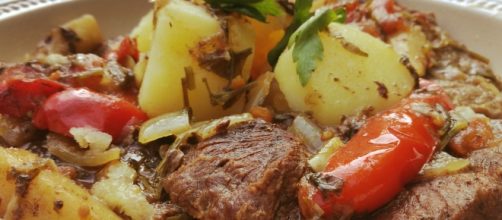A pinch of history
My balkan mum swears she invented this recipe, and after failing to find any beef dish, even in the Balkans, with the same delicious flavour, I was starting to believe her, until I visited a restaurant in Jerusalem. There I tried a dish called ‘beef superior’. Its liquor was identical to my mother’s ‘govedina’. How could this be? My mum came from Slavonia and the ‘beef superior’ appears to be a speciality of Jewish cuisine.
So here’s a theory: These days Slavonia comes under the jurisdiction of Croatia and borders Hungary and Serbia, but it has changed hands more times than half a bottle of cheap vodka in a park full of tramps.
At one time—before the last couple of wars—Slavonia had a healthy mix of Serbs, Croatians, Hungarians, Jews, Germans and Roma, and I like to think that there was a lot of talk over garden fences about cooking techniques and ingredients. My mum’s dish probably has its roots in the cooking traditions of the Balkan Jewish communities, which would explain why I ended up in Jerusalem before I found a carbon copy of one of my favourite home cooked dishes.
I have included a lettuce salad with this dish, as it’s quite common to see a bowl of cold crisp lettuce dressed in simple vinaigrette, sitting on the table next to it. It works well, serving to cool and refresh the palate during the meal.
Slow-cooked Slavonian Beef
Serves 4-6
1. The beef steaks should be about an inch to two inches thick. If need be, cut them into assorted sizes so that you have about six to eight pieces. I like to mix up the cuts using shin, flank, brisket and skirt.
2. Make a marinade with two tablespoons of sunflower oil, a teaspoon of salt and crushed pepper, a teaspoon of mild Hungarian paprika, a teaspoon of Vegeta, and four cloves of mashed garlic.
Marinate beef for at least one hour.
3. Put the lettuce in the fridge—so much better served cold, and don’t forget to preheat the oven to 150C.
4. Grease a good size casserole pot with a tablespoon of sunflower oil. Quarter the onion into quarters, then half quarters and make a bed of onion in the bottom of the pot.
5. Chop parsnips and carrots into thick chips and scatter over the onion bed.
Take the bashed garlic from the marinade and decorate carrots and parsnips. Finely chop half the parsley and sprinkle over carrots and parsnips.
6. Place beef steaks on the vegetable bed. Deseed two red bell peppers, quarter and cover beef steaks with peppers. Finally, roughly chop four tomatoes and distribute of peppers.
7. Put a lid on the pot and place in your preheated oven. Cook for at least three hours. I say three hours but if after three hours if your steaks can’t be torn easily pop back in the oven for another half an hour—add half a cup of just boiled water if liquor in the pot is threatening to dry out.
8. About two and a half hours into cooking, peel, quarter, and boil potatoes. Set aside and when the beef is ready, switch off the oven, add boiled potatoes to the pot.
Keep pot warm in the oven until ready to serve.
9. Remove lettuce from the fridge, wash and tear leaves into pieces your mouth can manage. Drain thoroughly—I like to put the leaves in a clean tablecloth, pull the ends of the cloth together, and then stand in the garden waving the cloth bag of lettuce above my head in big circles as if marooned on a desert island trying to attract the attention of a passing biplane; you may prefer a salad rinser to dry your lettuce.
10. Dress the salad with a traditional vinaigrette of three parts virgin olive oil to one part white wine vinegar. Grind in a pinch or two of rock salt, whisk and dress.
11. Garnish with remaining parsley and serve with salad and rocks of fresh bread for liquor dipping.
Ingredients
1 kg of assorted stewing beef
1 large onion
4 tomatoes
400 ml beef stock
2 teaspoons of Vegeta* (or other vegetable stock)
2 parsnips
4 small carrots
2 red bell peppers
3 tablespoon sunflower oil
1 teaspoon of Hungarian paprika (or Spanish pimento) **
4 cloves of garlic
3 large potatoes
20g of flat leaf parsley
Salt and pepper
Salad
2 Lettuces
6 tablespoons of olive oil
2 tablespoons and 2 teaspoons of white wine vinegar
Rock salt
*Vegeta originates from Croatia and is the Balkan vegetable stock of choice. These days it is readily available in some supermarkets and most Polish corner shops.
I recommend a mild sweet Hungarian paprika, but you might prefer a hotter one, either way, ‘The Spice Shop’ offers the best variety of central European paprika in the UK. http://www.thespiceshop.co.uk.


